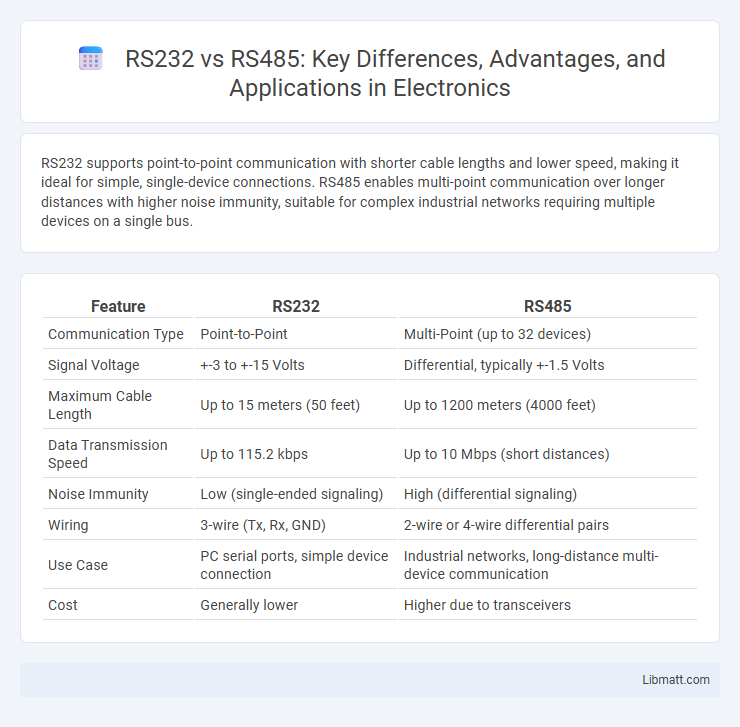RS232 supports point-to-point communication with shorter cable lengths and lower speed, making it ideal for simple, single-device connections. RS485 enables multi-point communication over longer distances with higher noise immunity, suitable for complex industrial networks requiring multiple devices on a single bus.
Table of Comparison
| Feature | RS232 | RS485 |
|---|---|---|
| Communication Type | Point-to-Point | Multi-Point (up to 32 devices) |
| Signal Voltage | +-3 to +-15 Volts | Differential, typically +-1.5 Volts |
| Maximum Cable Length | Up to 15 meters (50 feet) | Up to 1200 meters (4000 feet) |
| Data Transmission Speed | Up to 115.2 kbps | Up to 10 Mbps (short distances) |
| Noise Immunity | Low (single-ended signaling) | High (differential signaling) |
| Wiring | 3-wire (Tx, Rx, GND) | 2-wire or 4-wire differential pairs |
| Use Case | PC serial ports, simple device connection | Industrial networks, long-distance multi-device communication |
| Cost | Generally lower | Higher due to transceivers |
Overview of RS232 and RS485
RS232 and RS485 are two standard protocols for serial communication, where RS232 supports point-to-point connections with shorter cable lengths up to 15 meters, ideal for direct device-to-device communication. RS485 enables multi-point networks allowing up to 32 devices on a single bus over longer distances reaching 1200 meters, making it suitable for industrial environments requiring robust data transmission. Choosing between RS232 and RS485 depends on your system's need for distance, number of devices, and noise resistance.
Key Differences Between RS232 and RS485
RS232 and RS485 are serial communication standards with distinct electrical characteristics and use cases; RS232 supports point-to-point communication with a single transmitter and receiver, while RS485 allows multi-point communication with up to 32 devices on a bus. RS232 operates with unbalanced signals and shorter cable lengths, typically up to 15 meters, whereas RS485 uses differential signaling for improved noise immunity and supports distances up to 1200 meters. Your choice between RS232 and RS485 depends on factors like network topology, distance requirements, and noise environment.
Electrical Characteristics Comparison
RS232 supports single-ended signaling with voltage levels ranging from -15V to +15V, typically using +-12V for reliable data transmission over short distances up to 15 meters. RS485 employs differential signaling with voltage levels between -7V and +12V, enabling robust communication over longer distances up to 1200 meters and higher noise immunity. The balanced nature of RS485 reduces electromagnetic interference, making it ideal for industrial environments compared to the unbalanced RS232 standard.
Communication Modes: Point-to-Point vs. Multipoint
RS232 supports point-to-point communication mode, allowing data exchange directly between two devices with dedicated transmit and receive lines. RS485 enables multipoint communication, supporting multiple devices connected on the same bus with differential signaling for improved noise immunity. This makes RS485 ideal for industrial networks where several nodes communicate over longer distances.
Data Transmission Distances
RS232 supports data transmission distances up to 15 meters (50 feet) at standard baud rates, making it suitable for short-range communication in point-to-point connections. RS485 extends data transmission capabilities to lengths of up to 1200 meters (4000 feet), enabling reliable long-distance communication in multipoint networks. Its differential signaling reduces noise and signal degradation, ensuring stable data exchange over extended distances.
Maximum Data Rates
RS232 supports maximum data rates up to 115.2 kbps, which limits its use to shorter distance communication and slower data throughput. RS485 can achieve much higher data rates, often reaching up to 10 Mbps over short distances, making it ideal for industrial environments requiring faster and longer-range data transmission. Your choice between RS232 and RS485 should consider the data rate needs and communication range of your application.
Connector Types and Pinouts
RS232 typically uses DB9 or DB25 connectors with distinct pinouts designed for point-to-point communication, including pins for transmitting data, receiving data, and control signals. RS485 often utilizes terminal blocks or RJ45 connectors with fewer pins focused on differential signaling for multipoint communication, enabling longer cable lengths and higher noise immunity. Understanding these connector types and pin configurations ensures your device compatibility and proper wiring in industrial or serial communication setups.
Noise Immunity and Reliability
RS485 offers superior noise immunity and reliability compared to RS232 due to its differential signaling, which reduces susceptibility to electromagnetic interference in industrial environments. RS232's single-ended signals are more prone to noise over longer distances, limiting its effectiveness in harsh settings. Choosing RS485 enhances your system's robustness by ensuring more stable communication in electrically noisy conditions.
Typical Applications of RS232 and RS485
RS232 is commonly used in point-to-point communication for serial devices like computers, modems, and printers within short distances of up to 15 meters. RS485 excels in industrial automation, building management systems, and long-distance communication, supporting multi-point networks over extended ranges up to 1200 meters. Your choice between RS232 and RS485 depends on factors such as communication distance, number of connected devices, and noise resistance requirements.
Choosing the Right Standard for Your Project
RS232 offers simple, point-to-point serial communication suitable for short-distance connections up to 50 feet with low data rates, making it ideal for individual device interfaces and legacy systems. RS485 supports multi-point networks over longer distances up to 4,000 feet with higher noise immunity and data rates, enabling robust communication in industrial and complex environments. Your choice depends on the specific needs of distance, bus topology, noise tolerance, and the number of devices in your project.
RS232 vs RS485 Infographic

 libmatt.com
libmatt.com